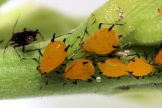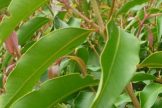
Myrtle Rust is a plant fungal disease that was first diagnosed in NSW in Myrtaceae family plants in April 2010
Myrtle Rust is now in Victoria. To a greater or lesser extent (depending on flora and climate conditions) this will change our landscape. It appears that we have no choice but to adapt and learn to live with this fungus. It attacks plants from the Myrtaceae family (list below), some are affected more badly than others (Lophomyrtus, Syzygium and Agonis). Badly affected species are referred to as host plants. We recommend that susceptible host plants be removed in highly infected areas, as re-infection after fungicide application is highly likely. Replace with non susceptible plants, preferably not from the Myrtaceae family.
Rust spores travel very long distances on the wind and may infect stands of susceptible plants many kilometres from the original infestation. Rust spores are also gathered and spread by bees.
Fungicides are effective in the control of Myrtle Rust. Rotation of fungicides between products containing different active ingredients is recommended to ensure fungicide applications remain effective.
Fungicides available to the home gardener for myrtle rust control on non produce plants (i.e. do not use for food plants) are:
Copper oxychloride. Use at 30g per 10L water and leave a minimum of 7-14 days before spraying again.
Mancozeb. Use at a rate of 23g/10L water and leave for a minimum of 7 days before spraying again.
Triforine. Use at a rate of 13ml/10L water and leave for a minimum of 7 days before spraying again.
Do not use any of these sprays more than twice in a row before switching to an alternative spray. Spray to the point of run off. This means just that – stop spraying before the spray runs of the plant – you want a fine mist all over the surfaces of the plant, you don’t want it to run off.
Read the instructions on the label of the product and follow the instructions.
| Genus List of Myrtaceae | |||
|---|---|---|---|
| Acca | Cheyniana | Lophomyrtus | Pleurocalyptus |
| Accara | Choricarpia | Lophostemon | Plinia |
| Actinodium | Chytraculia | Luma | Pseudanamomis |
| Agonis | Cloezia | Lysicarpus | Psidium |
| Algrizea | Conothamnus | Malleostemon | Psiloxylon |
| Allosyncarpia | Corymbia | Marlierea | Purpureostemon |
| Aluta | Corynanthera | Melaleuca | Regelia |
| Amomyrtella | Curitiba | Meteoromyrtus | Rhodamnia |
| Amomyrtus | Cyathostemon | Metrosideros | Rhodomyrtus |
| Angasomyrtus | Darwinia | Micromyrtus | Rinzia |
| Angophora | Decaspermum | Mitranthes | Ristantia |
| Archirhodomyrtus | Eremaea | Mitrantia | Sannantha |
| Arillastrum | Eucalyptopsis | Mosiera | Schizocalomyrtus |
| Astartea | Eucalyptus | Myrceugenia | Scholtzia |
| Asteromyrtus | Eugenia | Myrcia | Seorsus |
| Astus | Euryomyrtus | Myrcianthes | Siphoneugena |
| Austromyrtus | Gomidesia | Myrciaria | Sphaerantia |
| Babingtonia | Gossia | Myrrhinium | Stenostegia |
| Backhousia | Harmogia | Myrtastrum | Stereocaryum |
| Baeckea | Heteropyxis | Myrtella | Stockwellia |
| Balaustion | Hexachlamys | Myrteola | Syncarpia |
| Barongia | Homalocalyx | Myrtus | Syzygium |
| Basisperma | Homalospermum | Neofabricia | Taxandria |
| Beaufortia | Homoranthus | Neomitranthes | Tepualia |
| Blepharocalyx | Hottea | Neomyrtus | Thaleropia |
| Britoa | Hypocalymma | Ochrosperma | Thryptomene |
| Callistemon | Kania | Octamyrtus | Triplarina |
| Calothamnus | Kardomia | Osbornia | Tristania |
| Calycolpus | Kjellbergiodendron | Oxymyrrhine | Tristaniopsis |
| Calycorectes | Kunzea | Pericalymma | Ugni |
| Calyptranthes | Lamarchea | Petraeomyrtus | Uromyrtus |
| Calyptrogenia | Legrandia | Phymatocarpus | Verticordia |
| Calytrix | Lenwebbia | Pileanthus | Welchiodendron |
| Campomanesia | Leptospermum | Pilidiostigma | Whiteodendron |
| Chamelaucium | Lindsayomyrtus | Piliocalyx | Xanthomyrtus |
| Chamguava | Lithomyrtus | Pimenta | Xanthostemon |





